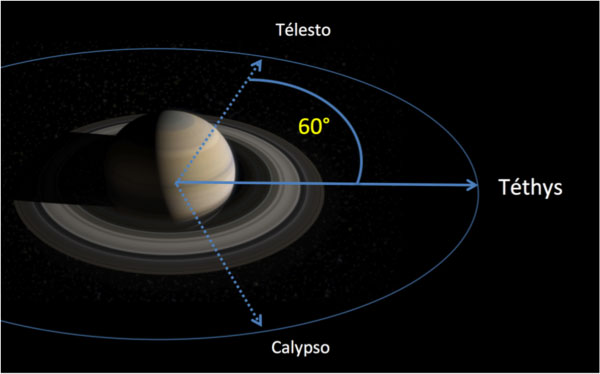The Saturn system, one of extraordinary complexity, is composed of 62 satellites, with various shapes, sizes and compositions. Since 2004, the Cassini probe has been orbiting the giant planet and providing a huge number of images of Saturn and its environment. After having analysed several thousand astrometrical images of about fifteen of Saturn’s moons, the international team ENCELADE has succeeded in quantifying for the first time the tiny variations of the gravitational field of the planet resulting from the tides raised by each of these moons.

The effects of tides arise due to the differential gravitational attraction of a celestial body exerted on the various portions of another. The body undergoing tidal deformation, in this case Saturn, will take on an ellipsoidal shape, like that of a rugby ball. This results in a change in its gravitational field, which will then, in turn, modify the motion of the bodies orbiting around it, in this case the moons.
Measuring the resulting tiny fluctuations in Saturn’s gravitational field would be virtually impossible without the close passage of the Cassini spacecraft around the planet or a dedicated space experiment. This challenge was however taken up by the ENCELADE team.
The method is clever : to be able to quantify these negligible fluctuations (a few parts in tens of billions), the researchers took advantage of a particular property possessed by two of Saturn’s moons, Tethys and Dione. Each of these moons shares its orbit with two other smaller moons, separated by an angle of +/-60°. From this “offset” position, the motions of the small moons are themselves affected by the deformation of Saturn associated with the tides raised by Tethys and Dione. While small, these changes are measurable because the fixed geometry of the system means that the effects accumulate, producing variations of a few tens of kilometres over ten years.
These new measurements of such tiny variations in the gravitational field of Saturn will now provide us with information crucial to a better understanding of the internal structure of the planet. Coupled with future measurements planned for the Cassini spacecraft at the time of its descent into the atmosphere of Saturn at the end of its mission in September 2017, this work will finally make it possible to assess the nature of Saturn’s core : is it rocky or is its density much lower ?
Applied to future observational datasets, this inventive method opens real prospects for a much better characterization for the internal structure of Saturn.
Reference
This research is published online in the journal Icarus, under the title “New constraints on Saturn’s interior from Cassini astrometric data”, on August 31st, 2016 (online version).

![<multi>[fr]pdf[en]pdf</multi>](IMG/gif/pdf.gif)